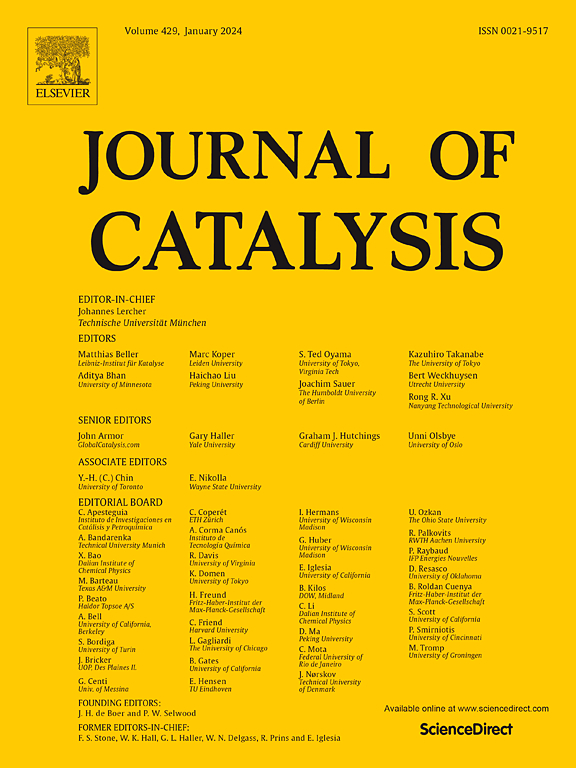Dual-S-scheme 0D/2D heterojunction of CsPbBr3/Agi-TiO2 for improved photocatalytic CO2 reduction: Enabling ultrafast interfacial charge transfer and product selective regulation
IF 6.5
1区 化学
Q2 CHEMISTRY, PHYSICAL
引用次数: 0
Abstract
Efficient carrier separation and catalytic microenvironment optimization are critical challenges in enhancing the coupling of photocatalytic CO2 reduction reaction (CO2RR) with H2O oxidation. Here, Ag-interstitial-doped TiO2 (Agi-TiO2) nanosheets were synthesized via stepwise solvothermal method and hybridized with CsPbBr3 ultrafine nanocubes to construct 0D/2D S-scheme CsPbBr3/Agi-TiO2 heterojunction. In-situ irradiated XPS (ISI-XPS) and femtosecond transient absorption spectroscopy (fs-TAS) verified that an Agi-mediated intermediate level (Agi-IL) initiated an additional interfacial charge transport pathway from Agi-IL to valence band (VB) of CsPbBr3. The CsPbBr3/Agi-TiO2 system exhibits dual-S-scheme characteristics, significantly enhancing the photogenerated charge separation. Furthermore, in-situ diffuse infrared Fourier transform spectroscopy (DRIFTS) combined with theoretical calculations revealed that the replacing long-chain oleylamine (OAm) ligands with short-chain octylamine (OTAm) on CsPbBr3 strengthens the binding affinity for *CO2 and *CO/*CHO intermediates, thereby modulating the product selectivity (CO vs. CH4). The CsPbBr3/Agi-TiO2 (CO: 143.7 µmol g−1h−1; electron selectivity: 91.7 %) and e-CsPbBr3/Agi-TiO2 (CH4: 57.2 µmol g−1h−1; electron selectivity: 78.0 %) showed good photocatalytic CO2RR activity and selectivity in the gas phase with H2O vapor as the proton source, without any sacrificial agents and cocatalysts. This study provides insights into the rational design of dual-S-scheme heterojunctions and the modulation of the reaction microenvironment in mixed-dimensional heterojunctions.


CsPbBr3/Agi-TiO2双s -scheme 0D/2D异质结改善光催化CO2还原:实现超快界面电荷转移和产物选择性调节
高效载体分离和催化微环境优化是增强光催化CO2还原反应(CO2RR)与H2O氧化耦合的关键挑战。本文采用逐步溶剂热法合成了ag -间隙掺杂TiO2 (Agi-TiO2)纳米片,并与CsPbBr3超细纳米立方杂化,构建了0D/2D S-scheme CsPbBr3/Agi-TiO2异质结。原位辐照XPS (ISI-XPS)和飞秒瞬态吸收光谱(fs-TAS)验证了agi介导的中间水平(Agi-IL)启动了从Agi-IL到CsPbBr3价带(VB)的额外界面电荷传输途径。CsPbBr3/Agi-TiO2体系具有双s -scheme特性,显著增强了光生电荷分离。此外,原位弥散红外傅里叶变换光谱(DRIFTS)结合理论计算表明,CsPbBr3上以短链辛基胺(OTAm)取代长链油胺(OAm)配体增强了对*CO2和*CO/*CHO中间体的结合亲和力,从而调节了产物的选择性(CO对CH4)。CsPbBr3/Agi-TiO2 (CO: 143.7 µmol g−1h−1;电子选择性:91.7 %)和e-CsPbBr3/Agi-TiO2 (CH4: 57.2 µmol g−1h−1;电子选择性为78.0 %),在水蒸气为质子源的气相中,不需要任何牺牲剂和助催化剂,表现出良好的光催化CO2RR活性和选择性。本研究为双s型异质结的合理设计和混合维异质结反应微环境的调节提供了新的思路。
本文章由计算机程序翻译,如有差异,请以英文原文为准。
求助全文
约1分钟内获得全文
求助全文
来源期刊

Journal of Catalysis
工程技术-工程:化工
CiteScore
12.30
自引率
5.50%
发文量
447
审稿时长
31 days
期刊介绍:
The Journal of Catalysis publishes scholarly articles on both heterogeneous and homogeneous catalysis, covering a wide range of chemical transformations. These include various types of catalysis, such as those mediated by photons, plasmons, and electrons. The focus of the studies is to understand the relationship between catalytic function and the underlying chemical properties of surfaces and metal complexes.
The articles in the journal offer innovative concepts and explore the synthesis and kinetics of inorganic solids and homogeneous complexes. Furthermore, they discuss spectroscopic techniques for characterizing catalysts, investigate the interaction of probes and reacting species with catalysts, and employ theoretical methods.
The research presented in the journal should have direct relevance to the field of catalytic processes, addressing either fundamental aspects or applications of catalysis.
 求助内容:
求助内容: 应助结果提醒方式:
应助结果提醒方式:


